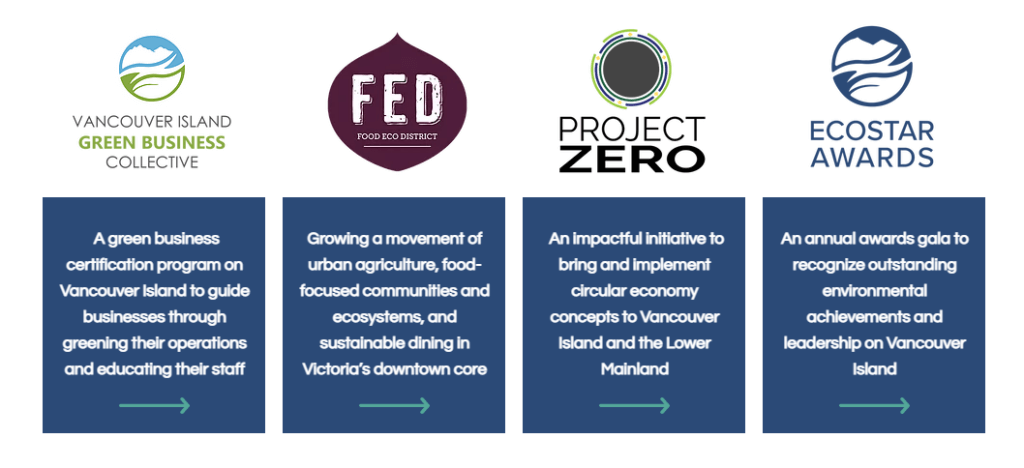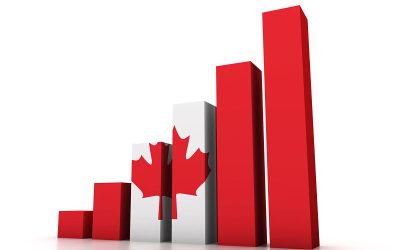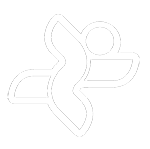As the world moves towards recovering from the COVID-19 pandemic, many questions have been asked about what recovery could and should look like. Some of these questions have been centered around the type of economic model that many regions around the world operate under and whether or not there are better alternatives that can be implemented. One such model is that of the circular economy and we asked local experts, the Synergy Foundation, to give us an overview of what this model looks like and how their work contributes to this shift in our region.
The Synergy Foundation; Local Circular Economy Experts
The Synergy Foundation is a Victoria-based environmental non-profit with a mission to share ideas, spark innovation, and activate change to steer our economy and communities towards a more regenerative, sustainable future. Through their core programs (Vancouver Island Green Business Collective (VIGBC), Food Eco District (FED), and Project Zero), they connect with businesses, educational institutions, policymakers, and youth based on the West Coast.

Synergy Foundation currently runs these four programs as they work to grow the circular economy model in BC and throughout the West Coast.
The Synergy Foundation program, Project Zero, is an initiative focused on bringing circular economy concepts to the region. Project Zero is a leading subject matter expert in the region on the circular economy. Project Zero runs a free 8-month incubator program for start-ups in the circular economy and hosts workshops to increase awareness and capacity. They also organize quarterly roundtable meetings with members from diverse sectors to focus on policy change and support circular economy initiatives. To fully understand the work that Synergy Foundation does on Project Zero, we first need to gain an understanding of what the circular economy is.
What is the Circular Economy?
According to the Ellen Macarthur Foundation, a circular economy is based on the principles of designing out waste and pollution, keeping products and materials in use, and regenerating natural systems. Currently, we live in a linear economy. This means that most of the products we purchase today are made from virgin materials and designed to be used once and then thrown away, destined for the landfill or ending up in our oceans.
For example, take the plastic milk jug in your fridge; it is made out of plastic which is manufactured using petroleum that is extracted from the earth. From there, it is filled with milk and distributed to grocery stores where you, the consumer, purchase it and take it home. Once you consume the milk, you will dispose of the jug and you may even put it in your recycling bin. Unfortunately, only 9% of plastics actually end up getting recycled. This means that your milk jug will likely end up in the landfill where it will take thousands of years to decompose. That’s a lot of carbon emissions associated with just the container for 2 litres of milk!
In a circular economy, waste and pollution are designed out of the system, keeping products and materials in use and regenerating natural systems. A model such as this drastically reduces our impact on the environment and requires far fewer virgin resources. The circular economy sees waste as a resource so, in the example of your milk jug, a circular economic model would ensure that it is recycled, shredded, and upcycled into a new product. This is what it means when something is referred to as containing post-consumer recycled (PCR) content! Watch this short video, created by Synergy Foundation, for a snapshot of the circular economy in our region.

The circular economy model encourages recycling, reconditioning, redistribution, reduction, reuse, and repair of resources that are then repurposed back into the system through renewable energy sources.
Opportunities in the Canadian Circular Economy
There are many unique opportunities within the circular economy and Canadian businesses are finding innovative ways to turn our waste into a resource. In Stratford, Ontario, CR Plastic Products is making premium outdoor furniture from PCR plastics. They use HDPE plastic, the kind found in milk jugs and pop bottles, and upcycle them into durable patio furniture; each Adirondack chair produced is made from 579 milk jugs! Here in BC, ChopValue takes upcycled chopsticks from Vancouver restaurants and transforms them into minimalist homewares and decor. To date, they’ve diverted 32 million chopsticks from landfills.
With pressing subjects like climate change and global economies committing to build back better after the devastating effects of the global pandemic, we are continuing to see more policies and economic trends that support the circular economy come to fruition. Globally, we are seeing banks being pressured to “tackle plastic pollution by making loans contingent on ambitious re-use and recycling schemes” as Matthew Green discusses in this recent Reuters article.
Earlier this year, BC released the Emerging Economy Task Force report which recommended “capitalizing on opportunities presented by the circular economy” to achieve their strategic priority of leveraging BC’s Green Economy. Through the Provincial government, they are also offering funding for initiatives that help steer us towards a more sustainable and resilient future, like the Recycled Plastics Manufacturing Stimulus Fund.

Plastic waste like these bottles can be turned into new products through a circular economy model.
The CleanBC Plastics Action Fund seeks to support projects in BC that are increasing the amount of PCR plastics in the supply chain and reducing our reliance on virgin plastics. For more information about the $5M fund and to submit your application, visit our CleanBC Plastics Action Fund webpage. Applications are open until 11:59 p.m. PST on February 15th, 2021.
Through the CleanBC Plastics Action Fund, Alacrity has brought in Victoria-based non-profit, Synergy Foundation, as a circular economy subject expert to support the assessment of applications. This post was written by Synergy Foundation staff to highlight what the circular economy is all about and how their work in the space supports organizations in operations using this economic model.


